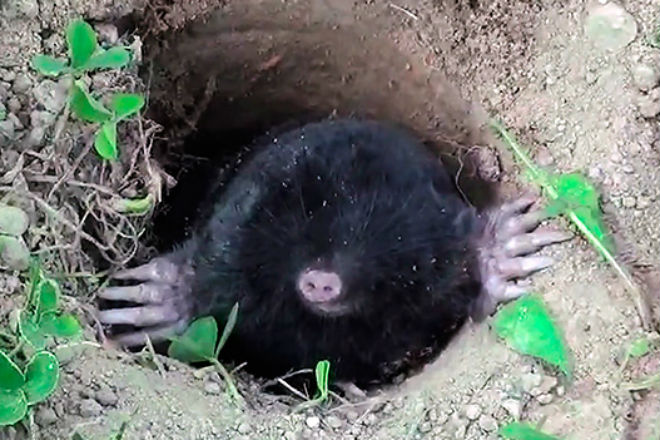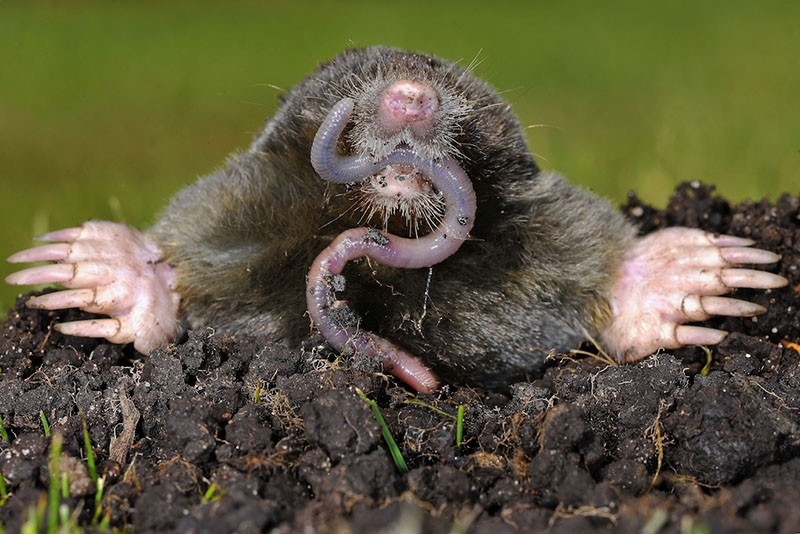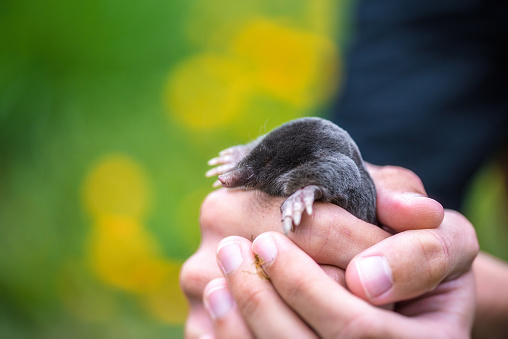Content
How long does a Mole live?
The average lifespan of a mole is 4-5 years, but can sometimes reach 7 years. However, natural death in moles is rare due to competition for territory, exposure to disease and human activity, which negatively affects their population.
The question of the life expectancy of moles is of interest, since their underground lifestyle makes them difficult to notice. Moles live in various places, including fields, meadows, forests, vegetable gardens and orchards, but they are quite difficult to observe.
It is known that the main part of the diet of moles are roots and tubers. Therefore, they often settle near gardens and vegetable gardens, which creates a conflict with humans. Moles consider crops grown on plots as their property. They collect crops and create reserves for the winter, storing them, for example, in underground storage facilities.
These animals are forced to feed frequently due to the limited size of their stomach. Lack of food can lead to their rapid death.
Moles are thrifty creatures. Summer is easier for them as there is plenty of animal food available such as insects, worms and snails. At other times of the year, when food becomes scarce, moles turn to their reserves stored in special places.
However, despite their ability to save money, people often react to moles with displeasure. Instead of admiring this mysterious animal power of accumulation, people use various means to destroy it. They fill the dens with water using a drill, set traps and use poisons. As a result, moles' lives are often shortened. Diseases also threaten their survival, as moles are susceptible to various infections. They can be harmed by helminths and parasitic insects.
Despite all the dangers, moles live in wide areas, ranging from Europe to North America, covering Asia. It is worth remembering that these creatures play an important role in loosening the soil. Their work promotes better oxygen supply to the roots of plants in their surrounding area, stimulating their growth and development. Yields in areas where moles live are usually higher, except when they process the best part of the crop and store it in their underground storage areas. They can even steal garlic, they are so skilled in this matter!
The mole plays an important role in the ecological system of our planet and is important to preserve, like other animals. Unreasonable extermination of moles by humans can lead to an increase in the population of various mollusks, worms and harmful insects. As a result, the question will arise about who harms vegetable gardens and orchards more - moles or these pests. Natural ecosystems are closely interconnected, and moles play their part in this complex web of life, living for 4 to 5 years.
Lifestyle of a mole
Moles are often compared to rodents, but they have a significant difference: moles do not have such a powerful jaw as rodents, so they choose places with soft soil that they can dig with their paws.

In addition, moles can swim and cross small rivers, which is confirmed by underground passages that are interrupted in front of reservoirs and continue after them. However, moles are rarely seen on the surface, and even when they appear, they behave clumsily, as they are completely blind and are not used to the environment outside their tunnels. That's why they move by crawling. Their vision is limited only by the difference between light and dark.

External signs of moles include:
- A shiny skin with short black fur.
- An elongated proboscis with nostrils below.
—Large front paws, shovel-shaped, with palms facing upward.
- Small, poorly developed hind legs.
— Small eyes with poor vision.
— Body length from 110 to 170 millimeters and weight from 60 to 150 grams.
- Short tail.

Cute mole in a man's hands
The life cycle of moles includes:
- Females give birth to up to four cubs from February to May.
- Care of the cubs, which lasts up to nine weeks, during which they develop into adults.
— Creation of a new family after this period.
Moles spend most of their lives alone, with the exception of the breeding season. They rarely change their habitat and concentrate in one tunnel system. Moles use musk glands to attract mates and prey. To survive, they need to consume a lot of earthworms, and if access to them is threatened by depletion, they expand their tunnel system. These tunnels can be more than a hundred meters long and come in two types: foraging and for housing. In addition, moles need water, so they create passages that lead to bodies of water.

Habitats of moles and their types
The mole family prefers to live in deciduous and broad-leaved forests. However, they are also known to be gardeners' nemesis, as their search for prey often takes them into gardens and fields where earthworms and other insects live. Underground networks of mole tunnels can cause a variety of problems, including landscape disturbance and mounding, as well as the destruction of many crops. Moles prefer fertile soils and avoid peaty or sandy areas.
However, the presence of moles in vegetable gardens and garden plots can also be beneficial. They loosen the soil, making it softer and more moist, and they help reduce the number of pests that cause damage to plants. Moles, despite their activity underground, do not consume plants and roots in their food.
So, the main habitats of moles include:
- Meadows.
— Forests, especially young birch trees and deciduous coppices.
- Clearings.
— Places near roads.
- Garden plots.
— City parks.
Moles prefer areas that receive plenty of sunlight and contain plenty of food such as worms, grubs and insects. Also an important factor is the moderate humidity of the area. Moles avoid dense forests, pine forests, swamps and areas with strong root systems of plants. The choice of habitat also depends on climatic conditions, seasonal changes and food availability.
What do moles eat and what do they eat?
Scientists have long been interested in the diet of moles, and research results have established that the food of moles is exclusively of animal origin. Plant fibers can be ingested by moles accidentally or through animal food such as worms. However, even if plant food enters the mole's body, it is not able to digest it, and it simply passes through it.
To search for food, moles actively dig new tunnels, especially when the food source in old places is exhausted. If there is a shortage of usual prey, such as worms, insects and larvae, moles can eat small vertebrates, and sometimes even frogs and rats.
Due to their constant activity underground, moles expend enormous amounts of energy and need a lot of food to recover. They have a high metabolism and can eat food that weighs more than their own weight (70-140 grams) throughout the day. If the mole is very hungry, it can eat prey, such as a worm, entirely on the surface of the ground, but with a more moderate hunger, the prey is carried into the hole and eaten there.
Moles have an excellent metabolism, which allows them to digest food very quickly. For example, they can digest 50 grams of food in just 30 minutes, despite the fact that their stomach can only hold 20 grams. After 4-6 hours they are ready for the next meal, and between feedings there are usually breaks in the form of short sleepy periods.
In winter, moles are less active and less voracious, as they dig less and spend less energy.
To ensure supplies for the winter, moles can catch worms and only bite their heads, leaving them motionless but alive. These “immobilized” worms are then laid in rows along the walls of their passages.
In addition, moles need access to water, and therefore always choose habitats near bodies of water.
Reproduction of moles
Fertilization of female moles begins around the end of April or beginning of May, and the gestation period is 5-6 weeks. On average, each female gives birth to 5-6 babies. Usually, one female is limited to one litter during the year, but in some areas, such as in Belarus, two litters can occur.
Mole cubs are fed by their mother for 4 weeks. As they grow older, the young become aggressive towards each other. At the age of about 2 months they begin to lead an independent lifestyle.
Mass settlement of mole individuals occurs from the beginning of July and continues until the end of August. This process is fast, as the young can move at speeds of up to 5 meters per minute, and in 20 hours they are able to cover a distance of up to 650 meters. Adults can move even faster, reaching speeds of up to 50 meters in 20 minutes.
There are four species of moles found in Russia:
1. European mole (Talpa europaea) is the most common species living in the forest zone of the European part of Russia. This type of mole is considered the largest; their body length can reach 27 centimeters and weight - 320 grams. The hair on the tail is used for touch, allowing moles to move backwards inside their tunnels.
2. Altai mole (Talpa altaica) - found mainly in Siberia. This species is the second in size after the European one, reaching 20 centimeters in length and weighing up to 230 grams. Altai moles have open eyes, which are difficult to notice in their thick fur.
3. Small mole (Talpa levantis) - lives in the Ciscaucasia and Caucasus. This species is the smallest among moles, their body length does not exceed 11 centimeters and their weight is about 30 grams. Small moles do not feed on earthworms, like most other mole species.
4. Caucasian mole (Talpa caucasica) - also lives in the Caucasus and Ciscaucasia. This species has the peculiarity of a karyotype containing 38 chromosomes, as opposed to 34 or 36 in other species. The body size is average, with a length of up to 14 centimeters and a weight of 40 to 100 grams. This species is poorly protected, with the exception of some varieties found in western Georgia.
Previous